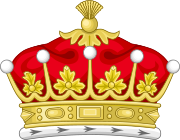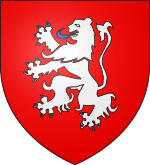Earl of Dunbar facts for kids
Quick facts for kids
Earldom of the March
 
The Arms of the Realm and Ancient Local Principalities of Scotland |
Imagine a powerful family in old Scotland, like a noble house, that held a special title called Earl of Dunbar. This title was also sometimes known as Earl of Lothian or Earl of March. An Earl was a very important leader, like a count, who ruled over a large area of land. This Earldom was in the south-eastern part of Scotland, and it existed from the early 1100s to the early 1400s.
The very first person to be called an Earl in this family was Gospatric II, Earl of Lothian. He was the son of Gospatric, Earl of Northumbria. The title was passed down through his family for many years. The last Earl in this first line was George de Dunbar, 11th Earl of March. In 1435, the Scottish parliament decided to take away his titles and lands. After this, George moved to England and was no longer a public figure. However, his son Patrick still kept a smaller noble title in a place called Kilconquhar in Fife.
The title of Earl of Dunbar was brought back much later, in 1605. It was given to George Home, who was an important government official called the Chancellor of the Exchequer. This new title was meant to be passed down to his male heirs. But sadly, George Home died just six years later, in 1611, and he didn't have any sons. This meant the title became "dormant," which means it was no longer officially used.
Even though some of his relatives were thought to be the rightful next Earls, none of them ever officially used the title. Today, there are no Earls of Dunbar. However, there are two other similar noble titles: Lord of Dunbar and Viscount of Dunbar.
Contents
First Creation of the Earldom
The Earldom of Dunbar was first created a long time ago, in the 1100s. The family who held this title used different names for it over the years.
Earls Using the Title "Earl of Lothian"
These were some of the earliest Earls who used the name "Earl of Lothian":
- Gospatric II, Earl of Lothian (died 1138)
- Gospatric III, Earl of Lothian (died 1166)
Earls Using the Title "Earl of Dunbar"
Later, the family started using the name "Earl of Dunbar":
- Waltheof, Earl of Dunbar (died 1182)
- Patrick I, Earl of Dunbar (1154–1232)
- Patrick II, Earl of Dunbar (1186–1249)
- Patrick III, Earl of Dunbar (1213–1289)
Earls Using the Title "Earl of March"
Eventually, the main title used by the family became "Earl of March":
- Patrick IV, Earl of March (1242–1308)
- Patrick V, Earl of March (1284–1368)
- George I, Earl of March (1340–1422)
- George II, Earl of March (c. 1370–1457)
Second Creation of the Earldom (1605)
The title of Earl of Dunbar was created again in 1605.
- George Home, 1st Earl of Dunbar (c.1556–1611) – He was the only Earl in this second creation. He died without any sons, so the title did not pass on.
After George Home died, some people claimed they should be the next Earl of Dunbar. For example, James Murray was given the title of Earl of Dunbar by a group called the Jacobite Peerage in 1721. However, the British government never officially recognized this title. Over the years, other families also tried to claim the title, but none of these claims were ever officially accepted by the government.
See also

